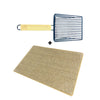We get it. Cleaning out a litter box and examining your furry feline’s waste may not be the most thrilling part of your day. But being able to tell the difference between healthy poop and not so healthy poop can provide very important insight into your cat’s overall health. So, without further ado, let’s talk about poo.
Understanding your cat’s stool can help you tell if their food is agreeing with them or if they may be experiencing a blockage or underlying illness. Most cats poop at least once per day. Frequency of their bowel movements, as well as the shape, color, and smell of the stool are good indicators on what’s going on in their digestive tracts. Getting in the habit of checking your cat’s stool during the daily litter box routine will help you keep constant tabs on how your furry friend is doing.
What to Look for in Your Cat’s Poop
Healthy cat poop is deep brown in color, but not black. Stool that looks black may mean there’s blood in it. As far as shape and feel, it should be almost malleable, not too hard but also not too soft, runny, or mushy. Think of a Tootsie Roll as a model example of a healthy turd. As for the scent, it’s of course not going to smell like roses, but your cat’s feces also shouldn’t reek so foul you need to leave the room or put on a mask just to get close to it.
If your cat is excreting small, hard balls of poop, that may be an indicator of constipation, which can lead to larger issues, such as hydration, metabolic concerns, or colon obstructions. If your cat also appears to be experiencing pain while passing the turds, this may be a sign of one of those issues.
Fur is often an ingredient you will notice in your cat’s poop. A little hair is perfectly normal. Though if it looks excessive, this may be a sign that your cat is over-grooming, possible because they’re anxious, have itchy skin, or have some kind of condition related to excessive shedding. If their turds are looking more like fur balls than poop, consider contacting your vet.
If your cat’s poop is consistently too light in color and entirely shapeless, you should take note. It’s not irregular for a cat to experience diarrhea, or other forms of mushy stool, if their food has been changed or they’re particularly anxious because of a car ride. However, if the diarrhea continues for more than 48 hours, that can lead to dehydration and may be a sign of more serious health concerns. If your cat is also experiencing a lack of appetite, decreased energy, and/or vomiting, it’s time to contact the vet.
Reasons Your Cat May Not Want to Go
If your cat isn’t pooping at least once per day, it may not be related to their health. Sometimes it has to do with behavior or lifestyle issues around the cat’s litter box. Here are a few potential things to look into:
· Is there competition with other cats for the litter box?
· Is the litter tray dirty?
· Did you recently bring home a new pet?
· Have you changed your cat’s environment or routine in some way?
· Does your cat not like the type of litter you’re using?
· Is the area the litter box is in highly trafficked or loud?
· Is your cat not getting enough water?
If the answer to any of these questions could potentially be yes, consider making some changes and seeing how your cat responds.
Although our furry friends cannot verbalize how they’re feeling and if something is wrong, they do show us in many other ways. Make sure to be constantly observing your cat’s behavior, eating habits, and the health of their stool to gain insight into how they’re doing.
Speaking of cat poop...have you made the switch to the highest performing natural cat litter on the planet yet?














